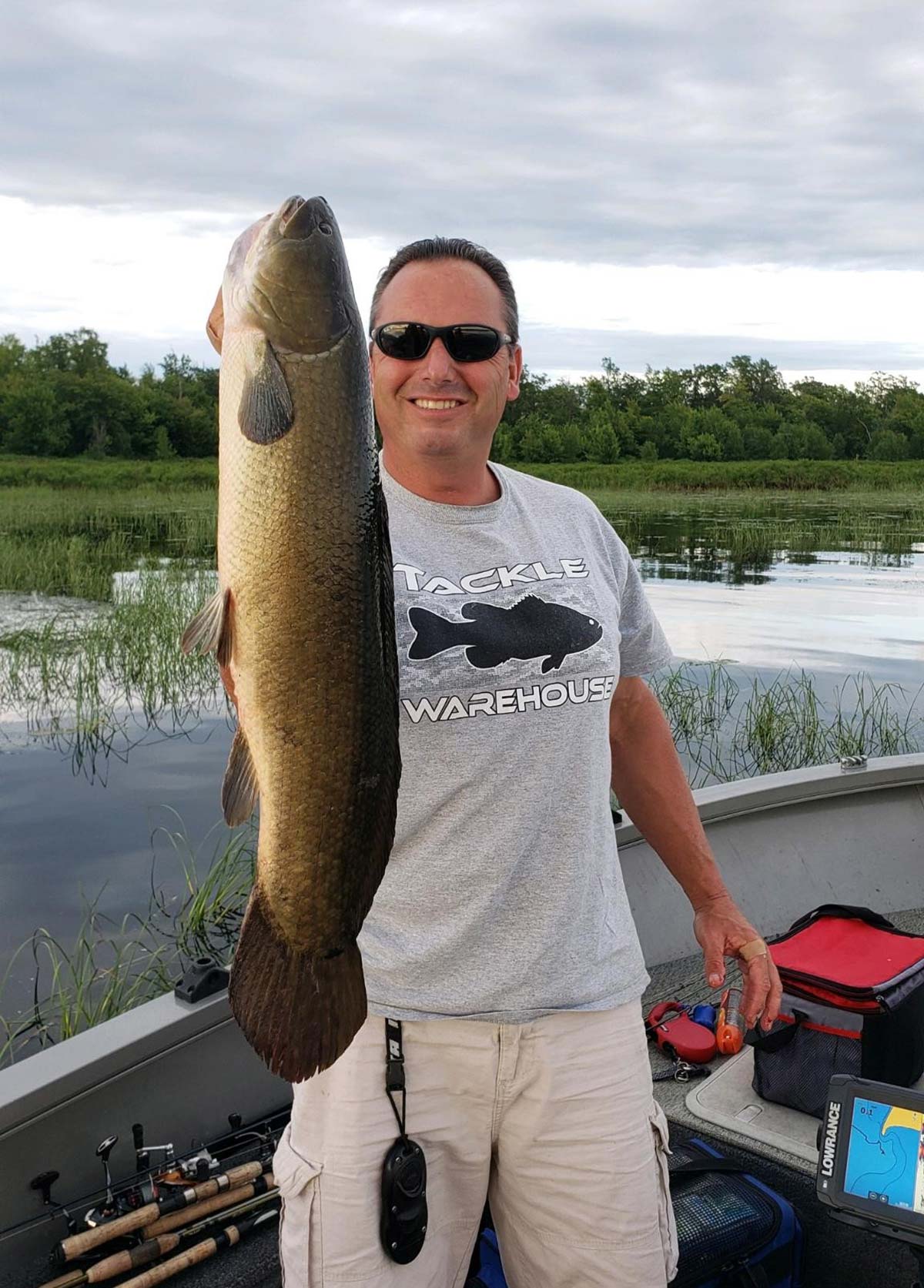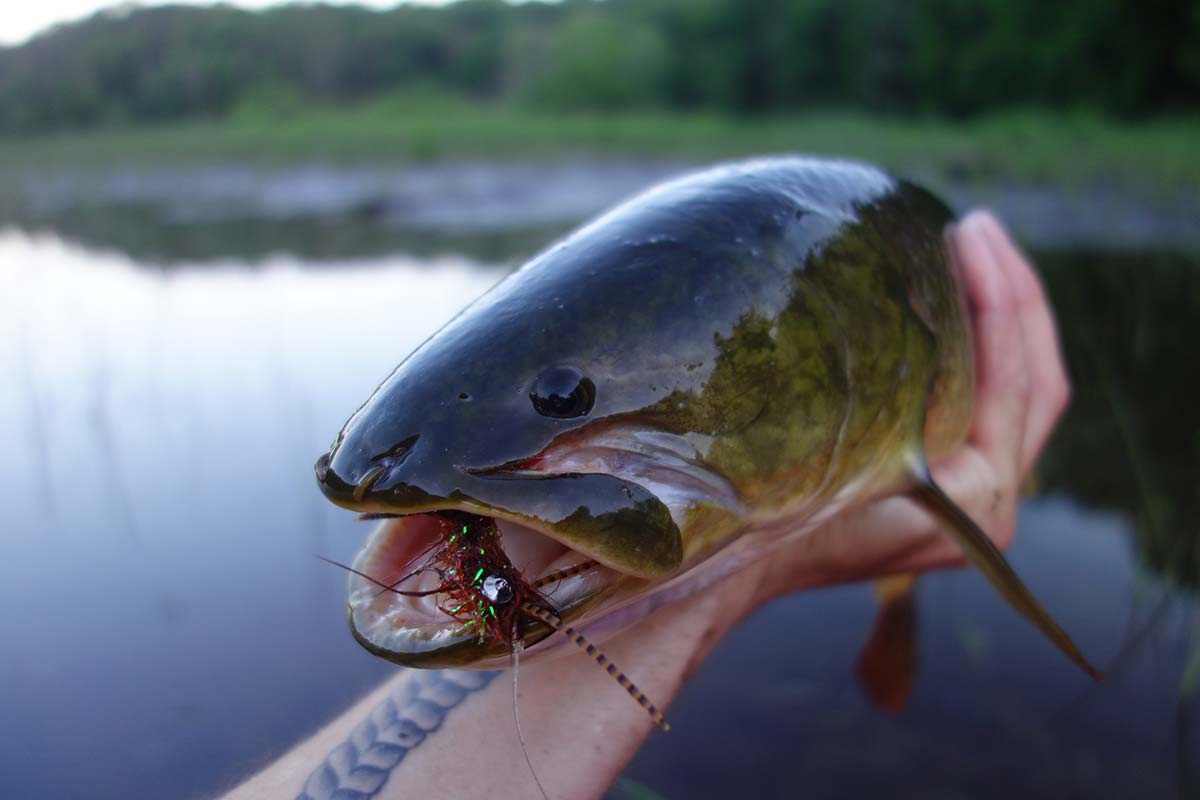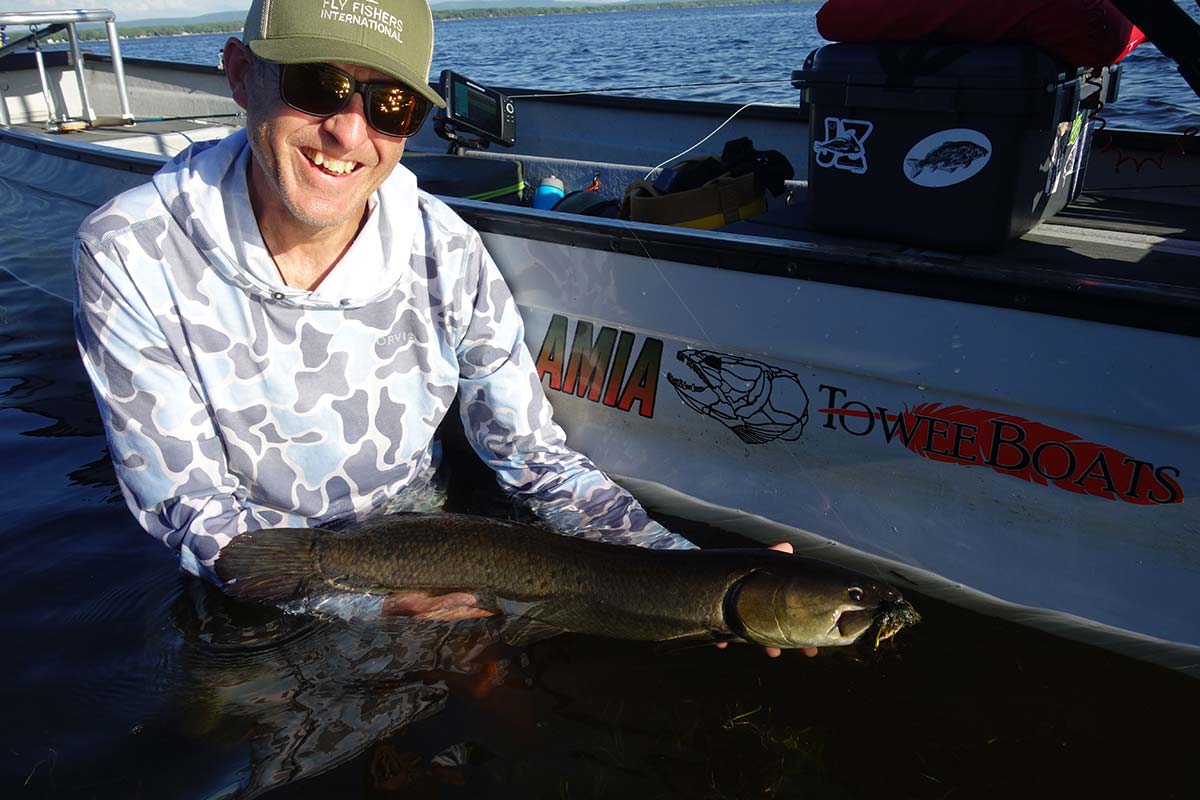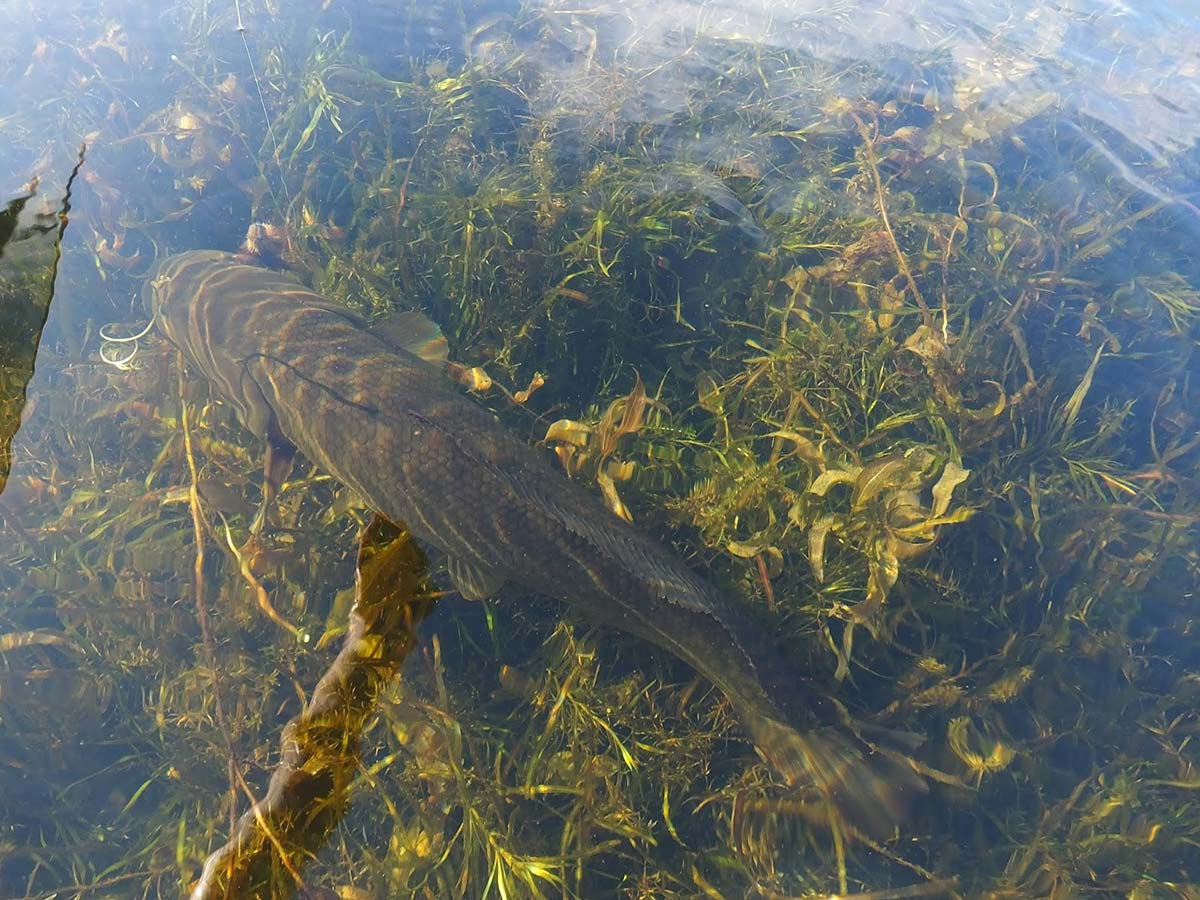
A prehistoric fish with a reputation for intense battles and a flair for the dramatic!
Sliding through a shallow, weedy Connecticut River backwater in a kayak, I peered into the mildly murky water. A few sizeable largemouth bass darted out of the lily pads, but they weren’t the quarry of the day. I was after something else entirely. In time it revealed itself, hovering in the milfoil, nearly stationary: a bowfin, Amia calva.
This ambush predator hardly moved a muscle as I made my stealthy approach. Its green fins and tail spot made it appear out-of-place in a New England backwater, more like an aquarium fish than something wild. Careful not to make any bumps or bangs, the paddle was traded for a fly rod. Tied on the end of a short leader was a heavy-hooked concoction of marabou, rubber legs, and chenille. As soon as the fly sank into its territory, the fish’s elongated dorsal fin began to ripple and it nosed towards the fly. With shocking abruptness the fish opened its mouth wide and inhaled the fly. I slammed the hook home, or so I thought, and the shockingly emerald and yellow belly of the fish showed as it thrashed at the surface. There were just a few moments of chaos before the hook pulled and I stood on my yak, dejected.
What’s A Bowfin?
Sometimes called mudfish, dogfish, or grinnel; bowfin have gotten more and more attention in recent years, and every bit of that attention is well deserved. They have been present throughout much of the eastern and midwestern United States for thousands of years. They’re the last of a prehistoric family of fish, true living dinosaurs. Those of us who have found that character appealing have often found ourselves wholly obsessed with pursuing them. Captain Drew Price who runs Masterclass Angling out of Burlington, VT is one such angler, and he’s been fishing for and guiding clients to bowfin on Lake Champlain for many years. “Bowfin are an incredibly unique fish, quite literally, they are the last of their kind which is very well represented in the fossil record. When you fish for bowfin you are fishing for an animal which is virtually unchanged for 300 million years. As if that wasn’t enough, they are excellent for sight fishing, they fight hard, they look cool, and they are full of surprises. There aren’t many other fish that will look you in the eye before taking a fly,” Captain Price told me.
The native range of bowfin wraps around the northern edge of the northeast, ending in Champlain. They’ve begun to appear throughout southern New England, though. They’ve been found in a small area of the Naugatuck River drainage, throughout the Connecticut River, and in the Taunton River. Bowfin are very tolerant of low-oxygen environments and warm water temperatures. They can breathe air and are often seen taking gulps at the surface. This makes them uniquely suited for shallow, muddy, vegetated backwaters, and these are often the places where they are concentrated. I have, however, seen them in everything from swift-flowing freestones to clear, sand-bottomed flats. Generally though, look for the shallow weedy water and that’s where the bowfin will be.

By Sight
Perhaps the most engaging way to catch bowfin is to sight fish for them. Fishing chunks of bluegill on the bottom or under floats could yield more and perhaps larger specimens, but the unique character of these fish really comes out when you get to watch one interact with and eat your offering. Anglers like Price and myself prefer to use fly rods. The length and taper of fly rods from 7 to 10 weight allow for a range of versatility that lends itself to bowfin fishing quite well. Tight drags and heavy tippets are required to deal with the fish’s violent rolling, teeth, and propensity to tangle in gobs of vegetation.
Bowfin fights are so intense that it isn’t uncommon that I still feel like I lost even when I have the fish in the net! They put most freshwater species to shame in terms of shear brute force and tenacity. Because of their tough, bony nature fly choice is important. Rather, hook choice in your fly. They need to be both needle sharp and beefy enough to sustain the rigors of the chore they’re put up to.
Capt. Price ties the bowfin fly of his own design name the Mr. Bow-Regard on very heavy gauge, short-shank hooks. “The Mr. Bow-Regard came about after using standard patterns. A typical hook just doesn’t cut it. They will work now and then but if you are routinely fishing bowfin the fly needs to be specific for the situation. It needs to sink fast, drive in easily and attract the fish’s attention. The Mr. Bow-Regard does all that and then some. It has had several iterations over the years but I am super happy with how I am currently tying it.” Drew’s fly features and marabou tail, rubber legs, and heavy lead eyes. It certainly gets the job done.

An Atypical Scenario
Unlike typical sight fishing scenarios, bowfin aren’t very inclined to spook. “Bowfin aren’t spooky, per se, but they are wary. When they approach a boat any loud noises coming from the hull or fast movement is typically a ‘hard no’ for them,” says Price. Whether wading, in a kayak, perched on a paddleboard, or in a boat, you can get much closer to bowfin than many other species. More often than not, we’re presenting to bowfin at rod length. For this reason, leader length is key.
Bowfin have incredibly hard mouths and a hard hookset is key. This fails if there’s too much leader in the way. “I use a very short leader- 4 to 5 feet, tops. I have my angler keep only about a foot of line out of the rod tip. If there is much more than that and the rod is at an angle, getting a hook set is almost impossible. Keep the rod parallel to the water and set by sharply raising the rod while it stays parallel to the water and repeat a couple of times to make sure the hook drives home. Do not ever set by using your wrist.” Price hits the nail on the head with this strategy. When I first started bowfin fishing, I missed a lot of fish using more conventional leader setups and holding the rod too high when presenting to the fish.
If fly gear just isn’t your thing, casting gear is certainly applicable as well. Your favorite setups for fishing jigs, heavy cover, or any close-quarters big bass fishing are probably up to the rigors of these prehistoric beasts. Heavy braid also gives the advantage of more easily slicing through thick vegetation. The same hook setting and presentation principles apply to both fly tackle and casting gear. Bowfin will often take a variety of jigs, chatterbaits, and soft plastic, but with sharp teeth and amazing jaw pressure, I don’t recommend using plastics that you don’t want getting mauled. For sight fishing, thickly skirted and somewhat lighter jigs will work very well even without a trailing plastic.

Presentation Is Important
In either case, presentation is often important. Price elaborates on this: “When presenting the fly close to the fish it can’t be ‘plunked’ in. It needs to enter the water quietly. The close presentation needs to be a vertical jig of about 8 to 10 inches and you need to watch the behavior of the fish. If they follow the fly, let them grab it. Wiggling it right in front of their face is right out. Just don’t do it.”
Bowfin will often show their interest in a lure or fly by undulating their elongated dorsal fin. If you see that thing start to move, brace for impact. They won’t always do that though, sometimes they’ll just grab without warning. Occasionally their takes are actually somewhat subtle. I recall a bowfin a client casted to taking so gently all it did was twitch its head to the side and open its lips. My client didn’t see the take at all. This variety of behavior speaks to the different character each bowfin can exhibit. It makes targeting them all the more engaging.
Back on the river, I was looking at another bowfin cruising slowly along a shallow bank. This one was a large female of maybe 8 or 9 pounds, an impressive fish though not nearly as big as they can get. When the presentation was made she ate the Mr. Bow-Regard almost immediately and with intense force. This time the hook stuck well, and the fish threw spray as it expressed its displeasure. After a couple minutes of close combat she was in the net. Looking down at a living relic of a bygone era, I wondered how anyone could dislike this species.
Bowfin are truly American fish. They have been around waters in North America since the days of Tyrannosaurus Rex or before and have survived that long relatively unchanged. They are incredibly intelligent (their curiosity shows that), long lived, tough as nails and one of the most fun fish out there. It’s unfathomable that so many people consider them “cull” or “trash” fish and hold other species in higher regard.
“I have heard bow-fishers in our area say that they are trying to improve things for largemouth bass by targeting bowfin. Well, the largemouth isn’t native to Lake Champlain and Lake Champlain has been one of the top five bass lakes in the country for the past 30 years,” laughed Capt. Price. Drew and I are far from alone in our admiration of bowfin, but hopefully their popularity continues to grow. There are far too many anglers that still look down on these incredible gamefish. If you’re on the fence about their value as a target species, all you need to do is set that hook and you’ll become a believer.



